Menus
- Victory Hammer in the test
- Hammer Hart – Part 1
- Hammer Hart – Part 2
- Technical specifications
- Technology news
- Noticed
- MOTORCYCLE measurements
- The competition
- MOTORCYCLE scoring
- Conclusion
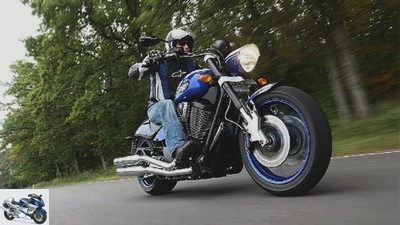
Jahn
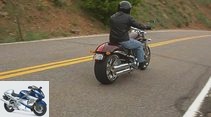
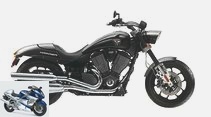

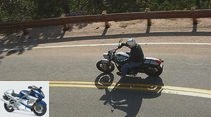
12th photos
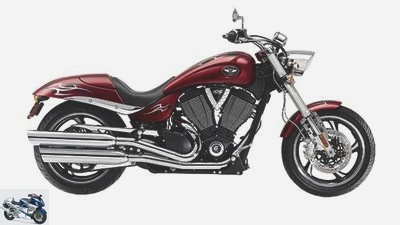
Victory
1/12
Victory hammer.
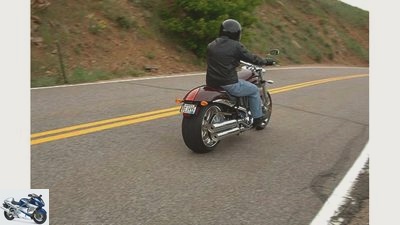
Victory
2/12
Victory hammer.
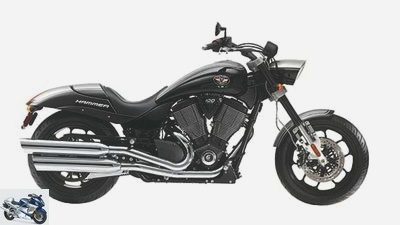
Victory
3/12
Victory Hammer S..

Victory
4/12
Victory Hammer S..

Victory
5/12
Victory Hammer S..
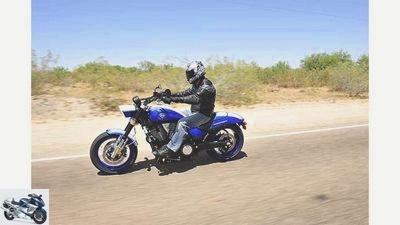
Victory
6/12
Victory Hammer S..
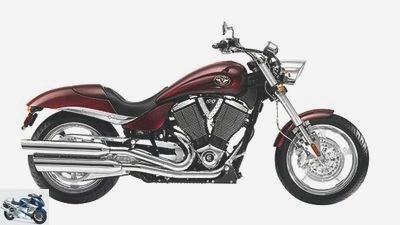
Victory
7/12
Victory hammer.
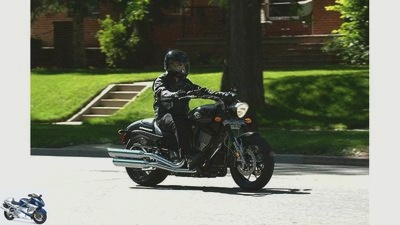
Victory
8/12
Victory Hammer S..
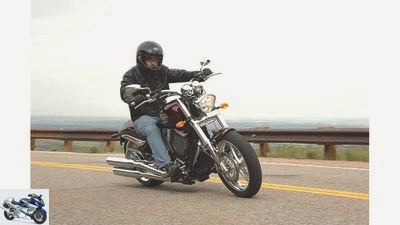
Victory
9/12
Victory hammer.
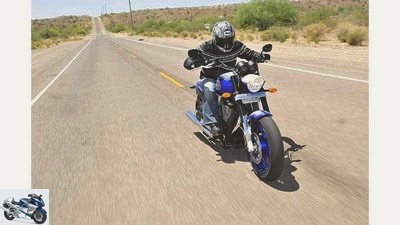
Victory
10/12
Victory Hammer S..

Victory
11/12
Victory hammer.
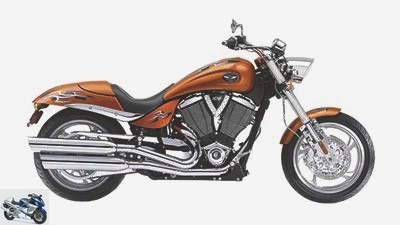
Victory
12/12
Victory hammer.
Top test: US cruiser
Victory Hammer in the test
So far, Victory has only operated on the American market. Now the still young manufacturer also wants to show Europeans where the hammer hangs – for example with a muscle cruiser, the Hammer S.
Hammer Hart – Part 1
Vno trace of modesty. Victory – is it sheer self-confidence or just the right name for a good business plan? In any case, the model name of the test machine underlines the profit intentions: hammer. No question about it, there could be a simpler way. But drumming is part of the craft – especially in the USA.
Buy complete article

Top test: US cruiser
Victory Hammer in the test
Victory for a while. To be precise, since July 4, 1998, the day on which the first work rolled out of an assembly hall of the parent company Polaris in Spirit Lake, Iowa. Today, eleven years after being launched, 40,000 planes with their wings spread out on the tank drive on the North American roads.
A year after MOTORRAD’s factory visit to Victory (issue 21/2008) and the first comparative test of the Vision Tour travel model (MOTORRAD 15/2009), this arouses curiosity about this brand. Especially on the hammer. The Muscle Cruiser (O-Ton Victory) stretches across the asphalt like a mixture of a cool chopper and a crouched drag bike.
The combination is optically successful. Especially in the tested S version (16,490 euros), which differs from the 1,000 euros cheaper basic version with its blue and white paintwork and filigree and lighter forged cast wheels. Everything looks minimalist and meticulously tidy. No trace of the pompous cruiser look, no excess chrome, hardly any plastic, no excess.
But it doesn’t work without overkill either. The rear tire is 250 millimeters wide over the rim. So far, 240 slippers were considered the most luxurious soles in series motorcycle construction. How magically the fat rear draws the eye, repeatedly distracts from the actually dominant element of the hammer: the mighty 50-degree Vau-Zwo. It is long, wide and high. Air-cooled, each with an overhead camshaft, four valves per cylinder, fuel injection, six-speed gearbox – as wrinkle-free as its surroundings.
And obviously thoroughly honest. While some competing models of the Euro 3 standard are cheating on the exhaust flap, the outlet of the Victory remains unmanipulated. The blow with which the starter pinion cuts into its counterpart is initially the loudest announcement of the 1731 V2 – acoustically closely followed by the hard one "Kalonk", with which the gear pair of the first gear engages. Let the easy-to-dose clutch come, and more than six hundredweight are set in motion via the secondary toothed belt. Oh yes, weight. The dimensions shift in cruiser circles. Compared to the 347 kilograms of a Suzuki Intruder, for example, the 315 kilograms of the hammer seem moderate.
Regardless of this, the low seat height (71 centimeters) and the fundamentally low center of gravity of a cruiser concept help to control the masses with unexpected ease. Once on the roll, the pounds seem to literally tumble off the American. That gives courage for the first corners. But experience warns: The wide tire fraction can take on frightening forms when tilted. Not a good omen. But the feared snaking ride does not materialize. The bike pulls its course in an astonishingly neutral way, just needs to be kept on course with a little counter pressure on the handlebars.
For a cruiser of this size by no means a matter of course and proof that the Dunlop Elite 3 tires (front in 130 size) obviously maintain an extremely harmonious relationship to the hammer geometry. Later on on the MOTORRAD slalom course, the Victory will emphatically substantiate this assumption. With times that are only just behind the pole setter in the chopper category, the Harley-Davidson V-Rod, the Hammer immediately moved into the top group in terms of driving dynamics.
Hammer Hart – Part 2
Jahn
Everyone should know: The sixth gear is designed as overdrive.
Nevertheless: freedom from lean angles, handling good and nice, but cruisers have to provide answers to other questions. Especially on this one: What driving feeling does it come across? In this respect the Victory is having a harder time. As I said – the sound remains subdued. And the archaic chopper feeling, which Harley cultivates perfectly, for example by pulsing the elastically mounted V2 while idling, hardly emerges. In this respect, the Victory Hammer is also straightforward in character.
Rigidly mounted, the big block, which is calmed by a balance shaft, resides in the tubular steel frame, shows a good nursery with moderate vibrations and prefers to convince through performance. And that in the literal sense. This 91 hp engine prefers to stage its definition of good vibrations through the enormous torque plateau, which it piles up powerfully between 2700 rpm and 5000 rpm. This full pressure, this powerful acceleration, this powerful pounding, with which the Victory starts shortly above idle speed, that is the charm of a muscle cruiser.
The ergonomics fit exactly with this character. Footrests instead of running boards, a tightly padded seat hollow instead of fluffy sofa cushions and the handlebars that are not pulled back too much add a touch of sportiness to the cozy feeling. However, the passenger also has to submit to this. The passenger seat under the attached cover looks just as spartan – narrow and sloping towards the rear – as the passenger footrests, which are attached to the cast aluminum swing arm on short arms.
Forget everything when the Victory follows the winding country roads with a gentle swing. The smaller the radii, the more graciously the toothed belt buffers the already low load change reactions and ensures a round line.
The suspension comfort is also surprising. While the non-adjustable upside-down fork withstands most of the hardships satisfactorily, the shock absorber, which can only be adjusted in the spring base, swallows small bumps surprisingly well despite the restrained 100 millimeter suspension travel. And even larger distortions, which cruiser pilots usually compress the cross, the monoshock takes its peaks – probably thanks to the progressive lever action, which is unusual in the cruiser segment.
Maybe that’s why courage comes up again. The clutch demands a determined grip, some feeling of precise, but somewhat bony gear changes. Then the Big-V pushes forward properly. The fact that fifth and sixth gear, designed as overdrive, lock at a measured 193 km / h, who cares?
It is more likely that the fuel consumption of 5.2 to 6.1 liters is within the usual range and that the 17-liter tank allows reasonable stage lengths. Or that for 140 km / h on the autobahn in sixth gear, 3000 revs are enough as in fourth for country road speeds of 90 km / h. Ideal to make the ride a relaxed pleasure by sliding on said torque shaft.
Especially since the Victory also shows sovereignty in decelerating. It takes a strong pull on the hand lever and a soulful step on the pedal, but then the hammer stops from 100 km / h after just 41 meters. A distance that is more than a meter below the previous reference value for the cruiser category set by the Harley-Davidson V-Rod – another record.
Then at the latest you begin to ponder. And is happy about this Victory, which has found its own way with excellent workmanship, a no-frills concept and a sporty focus. So that, as an American, within the narrow framework of the technical orientation accepted by the cruiser clientele, distances herself as far as possible from the Harley myth. Without emulating the Japanese cruisers who often search in vain for their own identity. And you know: Europe has always been enthusiastic about the golden mean.
Technical specifications
Jahn
Powerful: The 250cc rear tire sets the new record in series motorcycle construction.
ENGINE
Air-cooled two-cylinder four-stroke 50-degree V-engine, a balancer shaft, one overhead, chain-driven camshaft, four valves per cylinder, injection Ø 45 mm, alternator 450 W, battery 12 V / 18 Ah, mechanically operated multi-disc Oil bath clutch, six-speed gearbox, toothed belt, secondary ratio 2.12.
Bore x stroke 101.0 x 108.0 mm
Cubic capacity 1731 cm3
Compression ratio 9.4: 1
rated capacity 66.0 kW (90 PS) at 4900 rpm
Max. Torque 140 Nm at 3250 rpm
LANDING GEAR
Double loop frame made of steel, upside-down fork, Ø 43 mm, two-arm swing arm made of aluminum, central spring strut with lever system, directly articulated, adjustable spring base, double disc brake at the front, Ø 300 mm, four-piston fixed calipers, disc brake at the rear, Ø 300 mm, double-piston floating caliper.
Cast aluminum wheels 3.50 x 18; 8.50 x 18
Tire 130 / 70R 18; 250 / 40R 18
Dunlop Elite 3 tires tested
DIMENSIONS + WEIGHT
Wheelbase 1669 mm, steering head angle 57.3 degrees, caster 140 mm, spring travel f / h 130/100 mm, permissible total weight 532 kg, tank capacity 17.0 liters.
SERVICE DATA
Service intervals every 8000 km
Oil and filter change every 8000 km 4.0 l
Engine oil SAE 20 W 40
Idle speed 900 ± 50 / min
Air pressure front / rear Solo (with pillion passenger) 2.5 / 2.7 (2.5 / 2.7) bar
Guarantee two years
Mobility guarantee two years
Colours Blue / white, white / black / red
price 16,240 euros
Additional costs around 250 euros
Technology news
archive
The specifications for a typical cruiser look even influence the design of the Victory engine. The clutch sits on the transmission output shaft.
Vau like Victory
Establishing yourself in the cruiser segment without adopting the basic technical concept of the industry leader Harley-Davidson is difficult. The Victory product planners also submitted to this dictation of the market. The American drive unit is based on a V-engine with a cylinder angle of 50 degrees (Harley: 45 degrees) and is also very close to the local model.
Crucial differences result from the valve control. In contrast to the Harley counterpart (bumpers, two valves), Vic-tory relies on a technically more modern gas exchange with a chain-driven, overhead camshaft, rocker arms and four valves per cylinder. The resulting enlarged free valve areas and the lower moving masses allow the timing to be geared to the speed and thus the power. Against the background of the moderate maximum speed of 5700 rpm, the Victory unit still has plenty of reserves. Especially in combination with the stately displacement of 1731 cm³. The consequences: Firstly, the Big-V shovels over 140 Nm of torque to the rear wheel at 2500 rpm. Second, the relatively low specific power of 91 hp for this displacement means that water cooling can be dispensed with.
An essential prerequisite for the deliberately archaic look of a cruiser. How important the Victory designers take the styling, however, proves above all the effort for the execution of the motor housing, which is supposed to take over the appearance of the typical Harley, long engine with left-hand clutch. To do this, the clutch rotates loosely on the gearbox output shaft. But it is driven – in contrast to the chain primary drive at Harley – by an intermediate gear (turquoise).
As with the Harley models, the secondary drive is via a toothed belt.
Noticed
Jahn
Simple: the cover for the pillion seat is simply attached and the entire rear is styled without frills.
PLUS
Side cover and pillion seat cover are only plugged in and can be removed without tools.
The oil drain plug is recessed and therefore protected against unintentional contact with curbs.
On the side stand A rubber block reliably prevents unintentional folding when the motorcycle is parked.
Original accessories such as windscreens, luggage bags and of course clothing, Victory offers in abundance.
MINUS
The clutch lever is not adjustable in reach.
The front fender does not do its job in bad weather. Road dirt swirls up to the top of the tank when it rains.
The tool kit turns out to be lean: two Allen keys, a screwdriver.
MOTORCYCLE measurements
BILLION
Measurement data from motor and brakes.
DRIVING PERFORMANCE
Top speed
193 km / h
acceleration
0-100 km / h 4.2 sec
0–140 km / h 8.0 sec
Draft
60-100 km / h 4.5 sec
100–140 km / h 5.2 sec
140–180 km / h 8.2 sec
Speedometer deviation
Effective (display 50/100) 50/100 km / h
Tachometer deviation
Display red area 5800 rpm
Effective 5700 rpm
CONSUMPTION
at 130km / h 6.1 l / 100 km
Country road 5.2 l / 100 km
Theor. Range of the country road 327 km
Fuel type regular gasoline
DIMENSIONS + WEIGHTS
L / W / H 2400/1020/1250 mm
Seat height 710 mm
Handlebar height 1070 mm
Turning circle 6650 mm
Weight with a full tank 315 kg
Payload 217 kg
Wheel load distribution f / r 46/54%
DRIVING DYNAMICS 1)
Handling course I (fast slalom)
Lap time 23.5 sec
Reference V-Rod 22.3 sec
Vmax at the measuring point 91.3 km / h
Reference V-Rod 90.0 km / h
Despite the wide 250 mm rear tire, changing lean angles is easy. Only at the turning point does it have to be counter-steered forcefully.
Handling course II (slow slalom)
Lap time 34.8 sec
Reference V-Rod 34.2 sec
Vmax at the measuring point 44.2 km / h
Reference V-Rod 43.8 km / h
Footrests that touch down (see circular path) limit the speed at the measuring point. The tight chassis setup ensures high cornering stability.
Circular path (Ø 46 meters)
Lap time 13.6 sec
Reference V-Rod
Vmax at the measuring point 41.1 km / h
Reference V-Rod 41.9 km / h
The lean angle is acceptable. After the folding footrests, the frame sits on the left and the exhaust system on the right. Low erection torque when braking in an inclined position.
Brake measurement from 100 km / h
Braking distance 41.0 m
Previous reference V-Rod 42.2 m
The Hammer S impresses with excellent deceleration values.
To the ENGINE diagram:
With its torque curve already formed as a plateau from 2500 rpm, the Victory-V2 behaves in an exemplary manner. In fifth and sixth gear, the Hammer S is limited to 193 km / h. Hence the speed limitation to 4900 / min (5th gear) or 4200 / min (6th gear).
TO THE GRAPHIC BRAKING:
Braking without ABS is one of the most demanding tasks, especially with cruisers. In contrast to its counterparts, the front section of the Hammer S delivers an astonishingly good feedback – the foundation for the outstanding deceleration performance.
1) MOTORRAD test course, values from handling course and brake test averaged from the three best driving tests; Reference: motorcycle from the respective category with the previous best values; 2) Power on the crankshaft. Measurements on Dynojet roller test stand 250, corrected according to 95/1 / EG, maximum possible deviation ± 5%.
The competition
Manufacturer
The competition.
Harley-D. Fat Bob
Two-cylinder, six-speed, 78 hp, weight 319 kg, Vmax 195 km / h, consumption k. A. 15,495 euros *
Suzuki M 1800 R
Two-cylinder, five-speed, 125 hp, weight 347 kg, top speed 210 km / h, consumption 5.1 liters 14,380 euros *
Triumph Thunderbird
Two-cylinder, six-speed, 80 hp, weight 338 kg, Vmax 185 km / h, consumption 5.2 liters 14,590 euros *
*Additional costs included
MOTORCYCLE scoring
Jahn
Shiny number: No air-cooled cruiser without bare cooling fins – Victory adheres to the laws of the scene.
ENGINE
Just by their driving performance the Hammer S advances to the top group of the cruiser group. Nobody really cares that the top speed is limited to 193 km / h in the last two gears. After all, the V2 engine offers much more important virtues with smooth response and minimal load change reactions. The only drawback: the operation of the clutch and transmission requires extra pressure.
LANDING GEAR
That in terms of chassis quality It goes without saying that cruisers have completely different standards than conventional motorcycles. Under these conditions, the Victory does a remarkable job. Above all, the – relatively – neutral steering behavior is surprising. The feedback from the chassis remains moderate, as does the naturally limited banking freedom. Still acceptable: the suspension comfort.
EVERYDAY LIFE
Profane things such as wind protection or luggage storage are by no means part of the core disciplines of a cruiser – the Hammer S is no exception. After all, it offers the driver bearable seating comfort, offers a practical range and, above all, shines with high-quality workmanship. A big minus is it for the comfort offer for the front passenger.
SECURITY
The positive first: The excellent deceleration performance of the Hammer S sets a new record in the cruiser segment. And the negative? ABS is a nil. This is a major drawback, especially when it comes to the critical braking behavior of a cruiser.
COSTS
Apart from The Victory is easy on the wallet of its owner because of the considerable purchase price. Consumption and inspection costs remain in line with the class.
PRICE-PERFORMANCE
16,500 euros – the Hammer S cannot make up for this price handicap, even with its undisputed qualities. A straight four.
Conclusion
Jahn
Another record: The hammer’s deceleration performance sets the new standard in the cruiser segment.
Our conclusion: The Hammer S clearly shows that Victory took its time to venture into Europe. The US bike is not only first-class workmanship, but also impresses – for cruiser conditions, mind you – with its balanced handling, sophisticated engine and excellent brakes. Even more important: the Muscle Cruiser hits the scene with pinpoint accuracy.
Related articles
-
Top test: Victory Cross Roads Deluxe
fact Top test: Victory Cross Roads Deluxe Victory Cross Roads Deluxe in the test For the Cross Roads, a cross between cruiser and tourer, the moment of…
-
Comparison test: Harley-Davidson Softail Rocker C and Victory Jackpot
fact comparison test Cruiser, Harley-Davidson Rocker C, Victory Vegas Harley-Davidson Softail Rocker C and Victory Jackpot First of all: The Victory …
-
Victory Hammer S – endurance test interim balance
Gargolov endurance test interim balance Victory Hammer S The cruiser in endurance test Victory – the American company appeared out of nowhere in 1998 and …
-
Endurance test final balance Victory Hammer S
mps photo studio 14 pictures Bilski 1/14 endurance test final balance of the Victory Hammer S – disassembled after 50000km. Bilski 2/14 From the pole wheel are small …
-
Moto Guzzi Audace, Triumph Thunderbird Commander and Victory Hammer S
Bilski 32 pictures Bilski 1/32 Strength meets glory and longing. It is the pure teaching of enjoying driving, taking off with …
-
Comparative test cruiser from Harley-Davidson, Moto-Guzzi and Victory
Bilski 42 pictures Bilski 1/42 Harley-Davidson Softail Deluxe, Moto Guzzi California 1400 Custom and Victory Judge and Cruiser comparison test. Bilski 2/42 …
-
Cruiser comparison test Harley-Davidson Forty-Eight, Indian Scout, Victory Gunner
Gargolov 24 pictures RG 1/24 RG 2/24 RG 3/24 RG 4/24 RG 5/24 RG 6/24 RG 7/24 RG 8/24 RG 9/24 RG 10/24 RG 11/24 RG 12 / 24 RG 13/24 RG 14/24 RG 15/24 RG 16/24 …
-
Yamaha FJR 1300 Tourer in the test
fact 38 pictures fact 1/38 Yamaha FJR 1300 in the top test. fact 2/38 Yamaha FJR 1300 in the top test. fact 3/38 Yamaha FJR 1300 in the top test. fact 4/38 Yamaha FJR …
-
Comparison test: Benelli TnT R 160, BMW K 1300 R, Ducati Streetfighter S
fact comparison test: Benelli TnT R 160, BMW K 1300 R, Ducati Streetfighter S The strongest and most extravagant naked bikes Life is too short to …
-
Power cruiser Ducati XDiavel S and Victory Octane in the test
www.bilski-fotografie.de 18th photos www.bilski-fotografie.de 1/18 Picture gallery, power cruiser comparison: Victory Octane and Ducati XDiavel S….